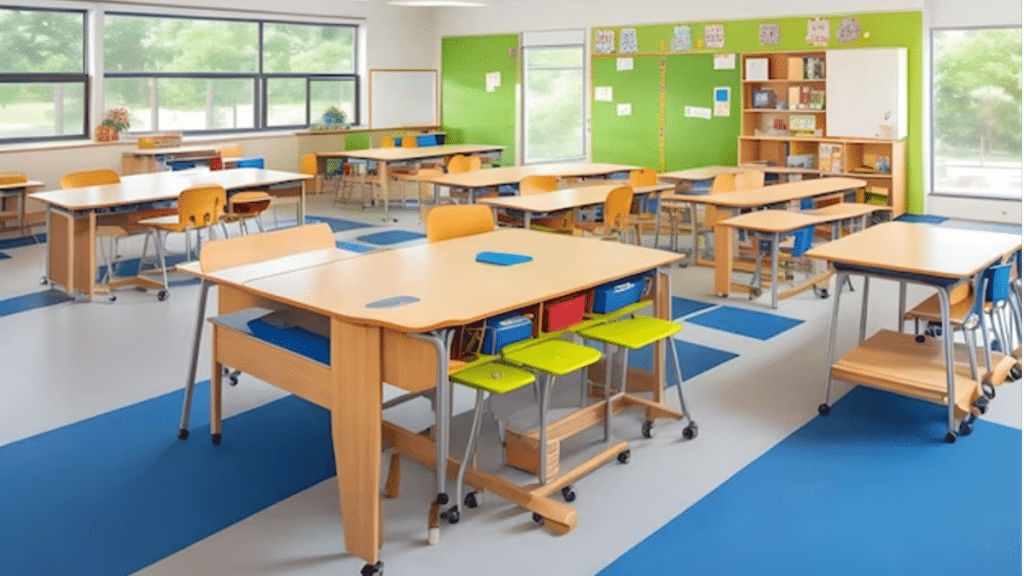When we think about factors that contribute to a successful learning environment, we often focus on teachers, curriculum, and technology. However, one often underestimated element that plays a crucial role in a student’s academic journey is the furniture they use. The design and quality of school furniture can significantly impact a student’s comfort, concentration, and overall productivity. This is where ergonomic school furniture comes into play, revolutionizing the way we think about classroom environments.
In this article, we’ll explore the world of ergonomic school furniture, shedding light on its benefits, features, and the positive impact it has on students’ well-being and academic performance.
The Importance of Comfortable School Furniture
Before we delve into the specifics of ergonomic school furniture, let’s understand why comfort matters in the classroom. Students spend a significant portion of their day at school, sitting in chairs and using desks. Uncomfortable furniture can lead to various physical and psychological issues, including:
1. Poor Posture
Inadequate seating can encourage poor posture, which can result in chronic back, neck, and shoulder problems. These issues not only affect a student’s physical health but can also distract them from learning.
2. Decreased Concentration
Discomfort can be a significant distraction. When students are fidgeting, shifting, or trying to find a comfortable position, their ability to concentrate on lessons is compromised. This can impact their academic performance.
3. Reduced Productivity
Uncomfortable seating arrangements can lead to decreased productivity. When students are uncomfortable, they may become restless, leading to disruptions in the classroom and reduced learning efficiency.
What Is Ergonomic School Furniture?
Ergonomic school furniture is designed with the goal of enhancing comfort, promoting proper posture, and improving overall well-being. Ergonomics is the science of designing products and environments to fit the people who use them. When applied to school furniture, ergonomic principles aim to create a classroom environment that maximizes students’ comfort and productivity.
Key Features of Ergonomic School Furniture
Ergonomic school furniture is not just about aesthetics; it’s about creating a conducive learning environment. Here are some key features that define ergonomic school furniture:
1. Adjustable Height
One of the primary features of ergonomic school furniture is adjustable height. Chairs and desks can be customized to suit each student’s height and body type. This adaptability ensures that students maintain proper posture and have a comfortable learning experience.
2. Lumbar Support
Ergonomic chairs often come equipped with built-in lumbar support. This feature helps students maintain the natural curve of their spine, reducing the risk of developing back problems in the future.
3. Ergonomic Desks
Ergonomic desks are designed to accommodate both left-handed and right-handed students comfortably. They provide ample space for textbooks, notebooks, and electronic devices, promoting an organized and efficient workspace.
4. Mobility
Many ergonomic chairs have wheels or gliders, allowing students to move freely within the classroom. This mobility encourages collaboration and engagement while also reducing the strain of constantly getting up and down.
Benefits of Ergonomic School Furniture
Investing in ergonomic school furniture offers a wide range of benefits that directly impact students’ well-being and academic performance:
1. Improved Comfort
Ergonomic furniture is all about comfort. Students can adjust their chairs and desks to find the perfect fit, reducing discomfort and distractions during class.
2. Enhanced Concentration
With ergonomic furniture, students can maintain better posture, leading to increased concentration and improved focus on their lessons. Fewer distractions mean more effective learning.
3. Increased Productivity
When students are comfortable and focused, they are more likely to be productive. Ergonomic school furniture can contribute to higher levels of productivity, which is essential for academic success.
4. Better Health
Properly designed ergonomic furniture can help prevent musculoskeletal issues like back pain and posture-related problems. By investing in students’ health, schools promote overall well-being.
Creating a Ergonomic Classroom
To create a truly ergonomic classroom, it’s essential to consider the overall layout and design. Here are some tips for creating a student-friendly environment:
1. Flexible Seating Arrangements
In addition to ergonomic chairs and desks, consider incorporating flexible seating options like standing desks, yoga balls, or bean bags. These alternatives allow students to switch up their positions, promoting movement and engagement.
2. Adequate Lighting
Proper lighting is crucial for students’ visual comfort. Ensure that classrooms have ample natural light and adjustable artificial lighting to reduce glare and eye strain.
3. Technology Integration
With the increasing use of technology in education, it’s essential to provide ergonomic solutions for electronic devices. Consider adjustable laptop stands or tablet holders that can be integrated into the classroom setup.
Conclusion
Ergonomic school furniture is a game-changer in the world of education. By prioritizing student comfort and well-being, schools can create an environment that fosters concentration, productivity, and overall success. Investing in ergonomic furniture is not just about enhancing the physical classroom; it’s an investment in the future of students’ health and education.
